As guitarists we love to solo over the blues, it’s exciting, creative, and there’s something about digging into a blues solo that just feels right. But, the reality is that we spend most of our time playing rhythm guitar when jamming with fellow blues musicians. Because of this, you need to make sure you’re prepared with enough riffs and chords to be creative and interactive with your rhythm blues playing.
This lesson helps you move beyond open and barre chords, as well as teaches you an essential blues rhythm riff to add to your blues playing.
Have fun with these riffs and chords, then take them to your next blues jam to take your rhythm playing to the next level.
Blues Riff Shapes
To begin, you learn the shapes used to create the rhythm riff in the G blues study below. Start by playing up and down these shapes in each key to become familiar with how they sit on the fretboard.
Use only your index and ring fingers to play these notes, no need to use your pinky here, as it’s your weakest finger.
After you’ve played through these shapes, move on to the chords in the next section.
G7 Blues Riff Shape
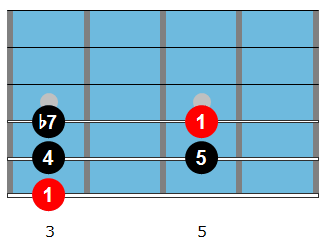
C7 Blues Riff Shape
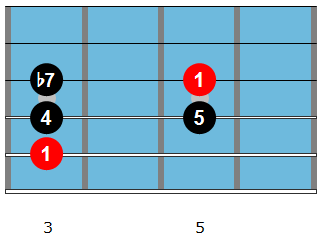
D7 Blues Riff Shape
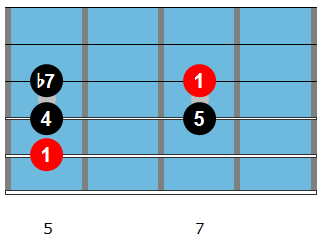
Blues Chord Shapes
Here are all three chord shapes from the G blues used in the two studies later in this lesson. Play through each one to become familiar with these shapes, and notice that they don’t contain a root note (or the root isn’t the lowest note).
You can visualize the root, although you don’t play it in the chord shape:
- G7: the root is on the 3rd fret of the 6th string.
- C7: has the root as the highest note in the chord shape.
- D7: the root is on the 5th fret of the 5th string.
Notice that the D7 uses a D7#9 sound (the Jimi Hendrix chord), to add tension over that bar in the progression. Using a 7#9 chord over a V7 is a common way to create tension and resolution in a blues chord progression. If you like that sound, take it out of this study and add it to your playing over other blues tunes.
G7 Blues Chord
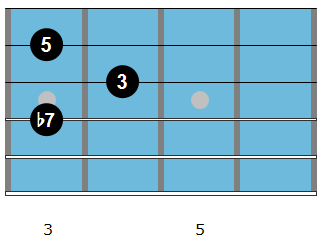
C7 Blues Chord
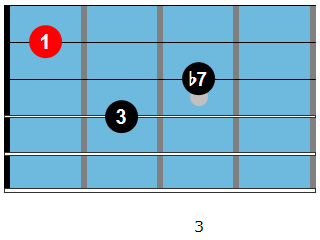
D7#9 Blues Chord
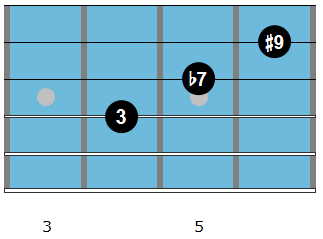
Blues Riff Study
You now move on to applying the riff and chord shapes to a full G blues, starting with the riff pattern.
The progression is a basic G blues (I-IV-V), but you can apply this riff to any variation of the blues progression you want to play.
Start by playing the study without tempo to get your fingers around the shapes and transitions between chords. Then, play along with a metronome until you get it up to speed and can jam it along with the track.
From there, practice it over the backing track in the last section of this lesson.
Listen and Play Along
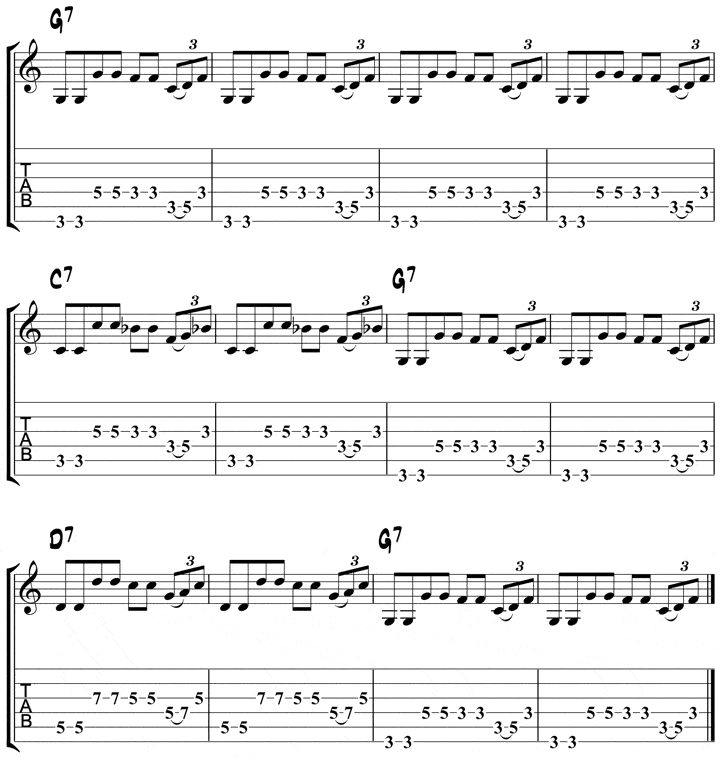
Blues Chord Study
You now work on the chords over the blues in G progression, playing on 2& and 4& in each bar.
The chord shapes aren’t overly difficult to get down with a little practice, but the rhythms can be tricky. Because of this, count along, work these shapes slowly with a metronome at first, then build up to playing the study with the track below.
You can also jump down and play these chords over the backing track, which has only drums and bass.
Listen and Play Along
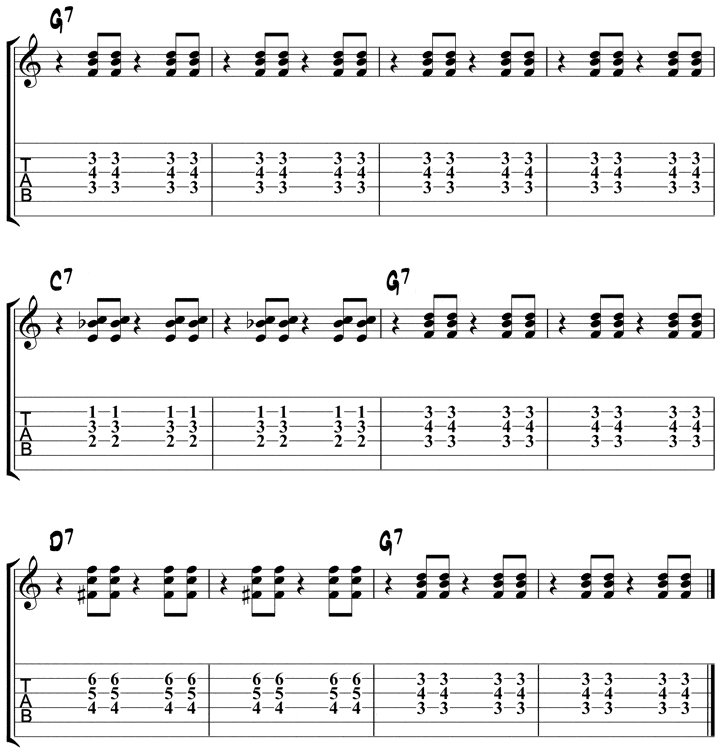
Blues Mixed Chords and Riff Study
Now that you have the two parts worked out separately you bring them together for a call and response type rhythm part.
You play the riff in odd bars (1-3-5-7-9-11), and the chords in even bars (2-4-6-8-10-12).
By doing so you mix the two textures in your accompaniment, creating variety and inspiration for a vocalist or soloist playing over your rhythm part.
Go slow with this study, as it takes time to bring both parts together. While you can play the riff and chords on their own, it’s the transition between the two that takes time to smooth out in your playing.
To get past this, use a slow metronome first, then increase the speed until you hit 100-120 bpm.
Then, when you can do that, play along with the audio example below before playing the study on your own over the backing track.
Backing Track
Listen and Play Along
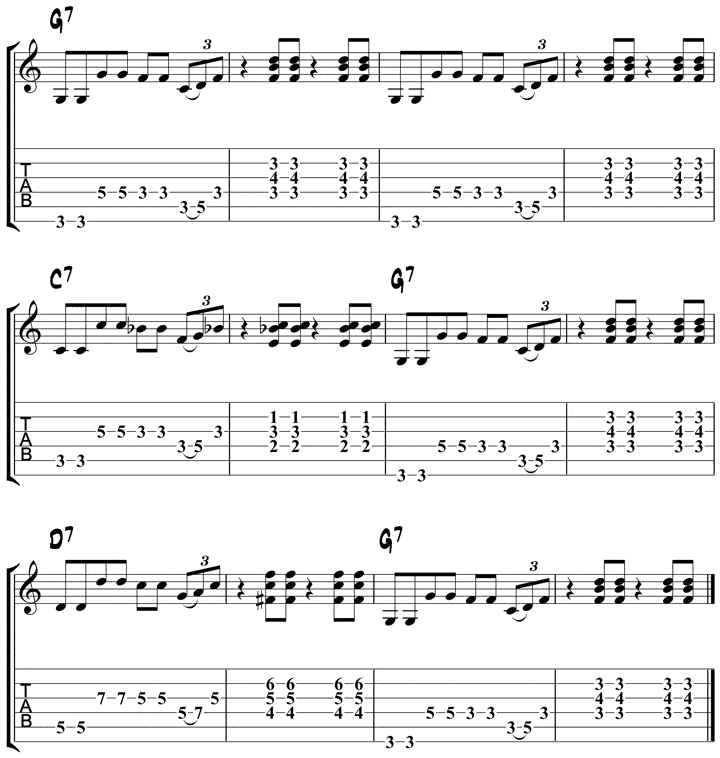


Hi Dirk, This is an excellent piece to build on for blues or jazz. This lesson is most helpful and challenging to play cleanly….Thank you
Thanks so much for making this material abailable
Hi Matt. This is a very inspiring and enlightening lesson Though the blues seem to be an easy chord progression with only three chords it is so difficult to master especially the call and response and the emotions these evoke. Thank you
Hi,I am very interested in this blues bundle however I purchased the blues 101 chord shapes some time ago is this the same as the one in the set because of so I would be paying for something i allready have. Look forward to hearing from you many thanks, Barry
I am looking for a book [or otherwise] that will show me Rhythm guitar comping and what to do while the Singer is singing or the Lead Guitarist is riffing. Whoever is authoring these books seems only to be sending Jazz homework. Most of the Blues is played in the Dom7 chordal patterns. Like a typical 12-Bar Blues in E…where the Bass is doing the bompabompabompa thing. I don’t want to just use inversions of the E-A-B . . . So, what’s out there?!!
check out these two, should be helpful https://www.jazzguitar.be/store/blues-rhythm-guitar.php
An expansion on what I wrote before. Looking on youtube tells me that there are at least two songs called “Night Train.” The one I had in mind is the oldie, which dates back to 1951 or 1952.
Merci !
How come you don’t set these up so we can print them like Matt does?
With little boxes to click on:
Print or Download PDF Email
Hi Lori, I installed a print (and pdf) button.
After a nap, when I tried to go to bed for real, this little riff came into focus. And as I thought about it a melody also arose. “Night Train” drops in with very little variation. The rolling little line plus the alternate rhythm chord double strike sounds just like a train clacking along. And I haven’t even listened to the backing tracks yet!